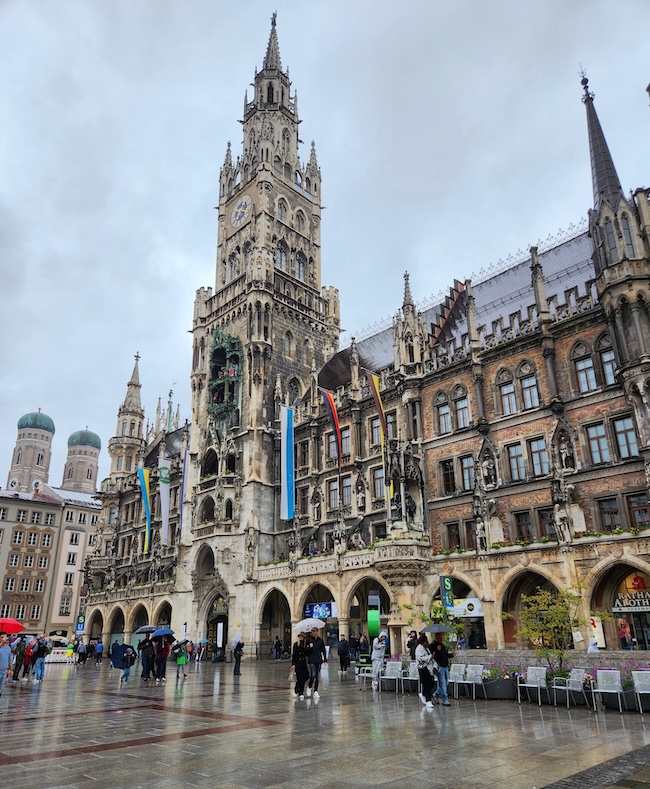Munich Dashes Preconceptions About Germany's Industrial Heartland
By Tom Kagy | 10 Aug, 2025
The Alps, Salzburg and Munich's unforgettable Old Town were the 5th and final leg of our 12-day Central Europe road trip.
From Ljubljana the A10 Freeway runs north over the eastern edge of the Alps. The early part of the drive traversed low undulating foothills. About an hour in we entered Austria and began encountering a series of tunnels. About halfway through Austria, just before the longest tunnel of perhaps eight miles, we were charged a $17 toll that seemed to cover several subsequent tunnels.
This picturesque rest stop offers views and relief on the grand sweep down the Alps toward Salzburg. (Photo, Tom Kagy)
In all we passed a half dozen or more tunnels, mostly ranging between a half mile and three miles. The tunnels were lined on both road edges with mesmerizing red lights. Driving the longer tunnels was surreal and slightly disorienting, something like driving on Rainbow Road in Mario Kart.
This view across the Salzach River in Salzburg shows Cafe am Kai and the hillside filled with historical structures. (Photo, Tom Kagy)
The most spectacular views of massive snow-capped mountains began appearing on the downhill side of the Alps crossing. What with the exhilarating grand slaloms down sweeping mountain curves, the final stretch of the drive to Salzburg was probably the most spectacular of our 12-day road trip.
Looking northward along the Salzach River provides a pastoral view of pre-industrial Salzburg. (Photo, Tom Kagy)
Salzberg is a picturesque little city of about 160,000 famed as the birthplace of Mozart. We navigated to the heart of its tiny entertainment/historic district in search of a charming restaurant with a pretty view for our mid-afternoon lunch break. Unfortunately there was no parking on the street. After a U-turn we drove about a half mile northwest to a nearby residential area and found street parking for which we were obliged to find a dispenser to buy a ticket for our dashboard at a cost of a couple of Euros.
Near Munich's Palace Hotel on Prinzeregentstraße we discovered the opulent Swagat Indian restaurant. (Photo, Tom Kagy)
After retracing on foot our route to the river's edge of the historic district, we went down a long flight of steps to the riverwalk. Immediately to our right was Cafe am Kai Salzburg, the charming riverside restaurant of our tourist daydreams. It was located perfectly below a hill dotted with the historic fortifications Monikapforte and Augustinerpforte a quarter mile uphill, and overlooking the broad, shallow Salzach River and, on the other side, the lush neighborhood comprising the iconic Mirabell Palace (Schloss Mirabell), Mirabell Garden and Mozart University (Universität Mozarteum Salzburg).
The Freedom Angel monument is the centerpiece of Munich's extensive, luxuriant river park Maximiliansanlagen. (Photo, Tom Kagy)
As with most restaurants in central Europe the understaffed service was as slow as the view was lovely. It took us nearly 40 minutes to get our two paninis and coffees for which the tab came to the equivalent of $34.47 according to our credit card statement, about 40% less than what we might have paid for a comparable, albeit less magical, eatery along the Central California coast. Still as our roadtrip progressed away from the eastern side of central Europe toward the west we began to notice prices creeping up.
After lunch we spent our limited break time crossing the Müllnersteg pedestrian bridge to the east bank of the Salzach. We felt a surge of tourist rhapsody, totally ravished at finding ourselves transported into a scene by Monet, a pre-industrial dream of riverine paradise, complete with spires, steeples and towers in the distance. On the other side we ventured a couple hundred yards toward the lush parklike grounds of Mirabell Palace but were constrained by our schedule to return riverward for a walk north toward the Eisenbahnbrücke rail bridge.
Crossing the bridge back to the west side of the Salzach afforded several more pastoral moments. On the other side was a fifteen minute walk back to our car and to Freeway 8 to Munich, a city ten times the size and the fifth and final stay of our 12-day roadtrip.
MUNICH
Munich (München) was the big surprise of our trip, not only because it's the center of a prosperous metro region of over 6 million. Munich is Germany's most affluent city and the world's 3rd most affluent. As headquarters of the Nazi party since its inception in the early 1920s, the city was extensively bombed during World War II. Consequently we had expected a stark industrial city with BMWs filling the streets. Instead we were to discover that most of the city's notable neo-Roman and Gothic structures in its Old Town (Altstdadt) were fully restored during the city's first three difficult post-war decades, spurred in part by the hosting of the 1972 Olympics.
We valet-parked at our Munich lodgings, the 5-star Hotel Munchen Palace located about a 15-minute walk from Old Town. It was pleasant enough, with luxe touches like real flowers in the lobbies and hallways. Overall its rather high room rates bought amenities comparable to the 4-star hotels we had enjoyed in the four eastern cities of our trip, reflecting generally higher German prices. On top of that, Munich is Germany's most upscale major city, with correspondingly higher prices than most of the country.
Our room was on the second level (3rd floor for us Americans), overlooking the main entrance on a quiet side street. By the time we checked in we were well into dinner time. We were considering a German restaurant on the other side of Prinzregentstraße only to find it closed. We walked a bit farther east and discovered Swagat Indisches (Indian) Restaurant. From the street we descended a half flight to enter one of the most extensive and opulent Indian restaurant we've ever visited. Its decor created the effect of a maharajah's harem, with folds of dark silk fabric billowing from the ceiling. A courtly host led us through two full salons to the sole empty table in a third salon with a large aquarium covering one side.
Our main waiter was a gruff heavyset man with the warmth of an executioner. He accepted grimly and without comment our order of vegetable pakora, saag paneer, tandoori chicken, garlic naan and beer. About half the guests in our salon appeared Indian. The relative speed with which our order was placed on the table and the quality of cooking were a pleasant surprise. Later when we checked our dollar-denominated bank statement we were again surprised by the tab: only $52.20, about 40% less than what we would have paid at our favorite local Indian. This explained Swagat's apparent success in an otherwise pricey town.

Asian American Success Stories
- The 130 Most Inspiring Asian Americans of All Time
- 12 Most Brilliant Asian Americans
- Greatest Asian American War Heroes
- Asian American Digital Pioneers
- New Asian American Imagemakers
- Asian American Innovators
- The 20 Most Inspiring Asian Sports Stars
- 5 Most Daring Asian Americans
- Surprising Superstars
- TV’s Hottest Asians
- 100 Greatest Asian American Entrepreneurs
- Asian American Wonder Women
- Greatest Asian American Rags-to-Riches Stories
- Notable Asian American Professionals

